April is a dynamic time to talk about fruit trees — as they are all blooming and flushing — and this last week I did so as the monthly speaker for the Ocean Hills Garden Club in Oceanside.
When allotted only an hour to cover “Growing fruit trees in Southern California,” only the vitals can be broached. But I did. I broached them.
Here I broach them again, with you:
SELECTION
Need chill? In Southern California, we can grow almost every type of deciduous fruit tree (think peaches, apples, plums, apricots, cherries), but we must be careful about choosing varieties that are suited to our relatively mild winters, usually of less than 500 chill hours. (For more on chill hours, see this article by the University of California. Also, see my posts “Messages from your deciduous fruit trees after the chilly winter (2018-2019)” and “Effects of a warm and wacky winter (2017-2018) on deciduous fruit trees.”)
Need heat? If you live within a mile of the beach, some citrus and other fruits that ripen early in the year are unlikely to get as sweet as you hope. To increase the chances of sweet fruit, leave fruit on the tree longer or choose varieties that ripen later in spring or summer like the Valencia orange or Gold Nugget mandarin.
Need a pollenizer? Some fruit trees are self-sterile, meaning they need the pollen of another tree in order to produce fruit, in quantity at least. Examples are certain plums and pluots. (See my post “Grafting a pollenizer branch into your fruit tree.”)
Size of tree is mostly controlled by you, not rootstock. Trees may be labelled “dwarf” or “semi-dwarf” but still get bigger than you want. No problem. You can control the size of any fruit tree — while still getting a lot of fruit — by pruning. (See my posts “Dwarf, semi-dwarf, and standard citrus trees: What are they, really?”; and “When and how to prune citrus trees”; and “Pruning avocado trees to keep them small”; and “My best advice on pruning deciduous fruit trees: Keep them small.”)
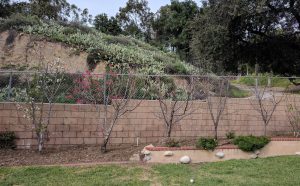
Planted these trees eight feet apart in my mom’s backyard in 2011/2012. (Cherry, peach, nectarine, plum, pluot.) On their own they would be twenty feet tall, but we prune.
(See also my posts, “Fruit trees for a year-round harvest in Southern California” and “What kind of fruit tree should you plant?”)
PLANTING
Full sun, all day, is generally best. Fruit trees planted in maximum sunlight produce more fruit, and have fewer health problems. (See my post, “Where to plant a fruit tree?”)
Don’t plant below grade. Always plant at or a few inches above the level of the surrounding soil. If the tree’s trunk is below grade, then water will collect there and make it vulnerable to crown-rotting diseases.
Bigger containers are better. If you must grow in a container, then go big, like half-wine barrel ultimately. It means you’ll have to water and fertilize less often, and your tree will be healthier because of the bigger soil volume and root system.
WATERING
Newly planted trees need more frequent watering than older trees. Also, if the tree had been in a container (not bare root), put the water right by the trunk for the first couple months. (See my post, “How to water a newly planted avocado tree.”)
Mulch of wood chips is magical. It will allow you to water less often and less in overall volume throughout the year. (See my post, “Using wood chips as mulch for fruit trees.”)
Don’t water wet soil. Most people seem inclined toward watering too often. Make it your goal to periodically dig to feel the level of moisture around roots before watering. (See this post, “Get your hands dirty to discover the truth about your irrigation practices.” )
FERTILIZING
Fertilize only as need is shown. Maxwell Norton, retired Farm Advisor with the University of California, wrote: “[Fruit trees] grown in backyard settings in typical sandy loam to clay loam soil with proper irrigation rarely need to be fertilized.” Many gardeners find this hard to believe, but it has also been my experience. Trees in containers are an exception, however. Norton’s statement comes from The Home Orchard, an excellent book (see my review here). (See my posts, “Fertile soil can be child’s play,” and “Fertilizing avocado trees.”)
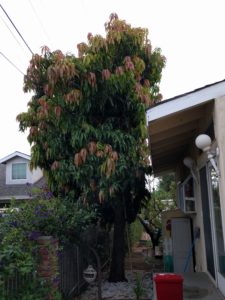
This mango isn’t given ideal watering or mulch, yet still looks great and fruits well without being fertilized.
PRUNING
Prune lightly more than once a year if trying to keep the size of deciduous trees down. And keeping trees small from the beginning is far easier than reducing the size of an old tree. (See my post, “My best advice on pruning deciduous fruit trees: Keep them small.”)
Do not thin canopies of citrus and avocado. A healthy citrus or avocado tree should have foliage so dense that you cannot see through to the other side. (See my posts, “How and when to prune citrus trees,” and “Pruning avocado trees.”)
Remove rootstock suckers. They will overtake the scion (the top part of the tree whose fruit you want) and eventually kill it. (See this post: “Beware of rootstock suckers on citrus.”)
FRUIT THINNING
Excess fruit can lead to sunburn and even branch breaking. Especially thin fruit that is near the tips of branches. (See my post, “Oh, the mistakes I’ve made: Not thinning enough fruit from a plum tree.”)
Fruit thinning is most needed on peaches and nectarines. It is rarely needed on citrus and avocado.
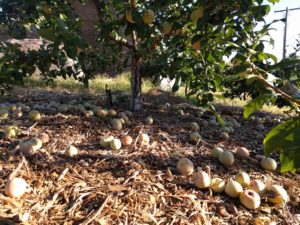
Fruit thinned from Dapple Dandy pluot tree. Should have thinned them before they got this big, but better late than never.
HARVESTING
Remember a tree’s harvest season with a birthday or holiday. Ask my son when we start picking Gold Nugget mandarins and he smiles, “On my birthday!”
Refer to a chart. See this chart by Dave Wilson Nursery for harvest times of deciduous fruit trees, and see this chart by Maddock Ranch Nursery for citrus and avocados. (Also see my post, “When to pick avocados.”)

I drew this chart to help me remember the harvest seasons for some of the avocado varieties I grow in my yard.
PESTS, ETC.
Plant in cages or kill gophers. They can easily kill young trees, though are not such a big deal for older trees. I’ve used many methods, but my favorite gopher trap by far is the Cinch Trap. (See my post, “The best gopher trap: It’s a Cinch.” )
Pesticides almost always hurt beneficial insects too. Their use can also put you on a “pesticide treadmill” since a pest’s natural enemies have been harmed and can no longer fight for you as effectively. Do your best to tolerate some insect damage. (See my post, “Don’t spray for citrus leafminers.”)

Citrus leafminer damage freaks many people out, but just leave it alone and natural enemies control it somewhat (although they don’t eradicate it).
All of my Yard Posts are listed HERE

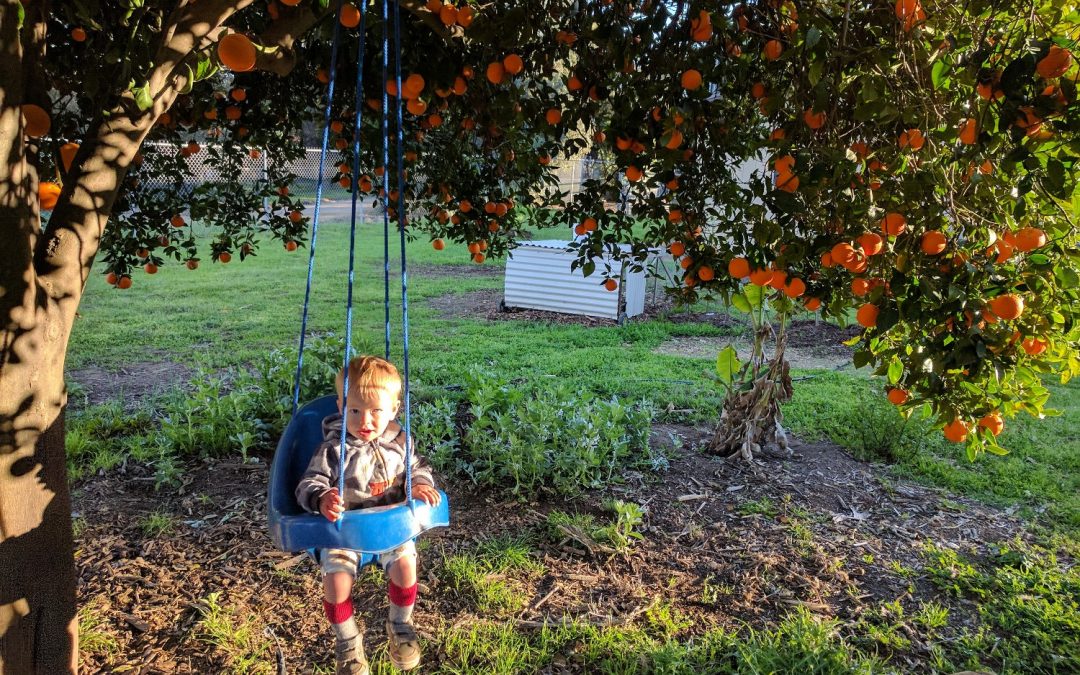
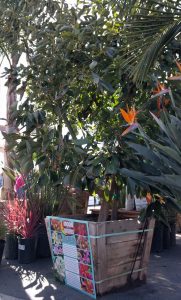
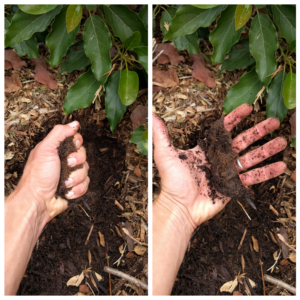
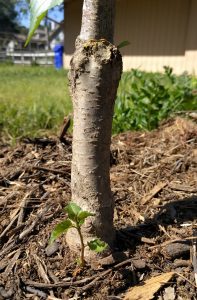
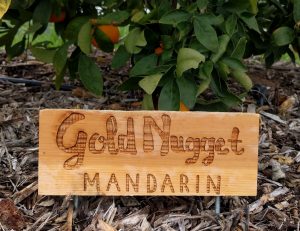


Really great post! You have answered a personal email from me and I really appreciated it! All your articles are keepers, especially this one. I am a new fruit tree mini-farmer – Anna’s Apple, Blenheim Apricot, Santa Rosa Plum and a Mandarin. I also have a Meyer Lemon in a big pot. I successfully pruned the apricot and plum in February (their 3rd year). Taking all your advice in today’s article with much appreciation!
Thank you, Judy. So good to hear feedback like this!
My kids bought me a peach tree for Christmas. I love in Oceanside. Wondering when the best time to put it in the ground and recommendations for adding into the hole? I have very sandy soil, near the riverbed.
Hi Jackie,
Nice kids! I’d put it in the ground now. I wouldn’t add anything to the hole — just refill with your dirt. You can add some compost or wood-chip mulch to the top of the dirt after planting, or sprinkle some fertilizer in the spring if you think your dirt needs it, but no rush. See how the tree grows through spring and summer, and then judge if it seems to need a boost of fertility. Often there’s no need for fertilizer.
Great information Greg!! Keep it up:)
Hi Greg,
Again thank you so much for your weekly posts. They have helped me to get informed and gain confidence. Your information is very practical. I do appreciate your attention to detail and above all the multiple links that provide extensive and detailed information about your advice. Now I expect your post every week. This weeks post is very informative.
Thanks so much, Juan. Glad to hear that you appreciate the links because I sometimes wonder if I overdo them.
I am in the early stages of starting a business and recently decided to include limited species of fruit trees in the mix. Your site was incredibly helpful in providing good information! Keep up the good work! Thank you!
I’m very grateful to hear this feedback, Amy. Good luck with the business, tell me more about it if you’re willing, and let me know if there are any other fruit-tree issues I can help with.
Hi thanks for an informative article. I mov dninto anhouse that has a 20+ year old apple tree. It has a lot of “suckers” on top that have grown straight up. It’s now September in LA and starting to cool a little at night. Can I prune?
Hi Gene,
Sure, you can prune an apple anytime. I lightly pruned my apples two weeks ago. This late in the year, you’ll likely get no regrowth until next spring.
We have a dwarf apple tree on a container and recently noticed “baby apple trees” growing at the base. I thought that was exciting but now I’m worried they’re suckers. Do I just pull anything new growing at the base? Or will they grow into healthy apple trees?
Hi Amy,
Those sound like rootstock suckers so you should remove them. They will probably be very healthy, but they won’t make the fruit that you want, and they will grow taller, shade, and eventually kill your original tree.
Any chance an avocado tree will survive and bear fruit in La Quinta? The zone, is it 13?, suggests no, but I would really really like to have an avocado tree. Thoughts?
Hi Kat,
I haven’t seen avocado trees in the Coachella Valley personally, but I’ve read of avocados surviving there, especially if given some shade. Apparently, some have grown them in the shade of date palms.
Avocados fruiting well is another issue since high heat kills avocado pollen. If the spring heats up too much too early, you won’t get any pollination.
One of these days I’m going to visit the area in search of the avocado trees I’ve heard of there. If you know of any, please tell me.
Hi Greg, thanks for posting all of this wonderful information on growing avocados in southern California! I do have a question that maybe you can help with. I live in a suburb in Mission Viejo CA, halfway between LA and San Diego about 18 miles from the coast. A few months ago I had three eucalyptus trees cut down and the stumps ground out. I would like to plant a couple of avocados where these eucalyptus were. One would be about 2 feet from where the stump of one was, and the other would be about 15 feet further out, Not much grew near these trees and I have read mixed opinions on whether or not the roots and ground would be poisonous to a plant like an avocado. Do you have any experience or insight here?
Hi Chris,
Thanks! There shouldn’t be a problem unless the stump grindings were incorporated into the surrounding soil.
In my old yard, I grew avocados near and even somewhat under eucalyptus trees. They did fine, except for the vigorous eucalyptus roots that invaded repeatedly in order to drink from my irrigation.
I’ve also used eucalyptus wood chips as mulch under many trees for many years, including avocados. It works great. I don’t know where the myth arose that eucalyptus are somehow poisonous, but I’ve never seen nor heard of any evidence for it.
Hope your new avocado trees do great!
Great, thanks Greg! There are a lot of Eucalyptus chips, I will dig them up and save them as mulch! A couple of other questions. First, I am planning on planting the “big three” (Hass, Reed Fuerte)! I read somewhere that Fuerte do not do that well near the coast. I am 8 (not 18) miles from the coast, not a direct flat path, lots of hills between Mission Viejo and the ocean, not sure if that is considered close or not. Any experience with that? Do I need to reconsider the Fuerte? Also, a local nursery recommended a Carmen Hass. Any experience with this? It is said to have more than one fruiting season.
Hi Chris,
Fuertes produce where Fuertes produce. It is often said that they produce better away from the beach but I know of Fuerte trees that produce very well within a couple miles of the beach. In fact, see the Fuerte tree in my post called “Can you grow an avocado tree in a small yard?” That tree is one mile from the ocean. It fruits extremely well year after year.
On the other hand, I know some Fuerte trees twenty to thirty miles from the ocean that barely fruit. (One of them is in my yard!)
So I advise that you plant your Fuerte, providing the benefit of cross-pollination with the Hass and Reed trees, and it will probably fruit fine, but you never know because Fuertes are mysterious and no one has ever figured out exactly why some don’t bear well.
I have only a little experience with Carmen Hass. I have a young tree in my yard, and I’ve seen older trees elsewhere. Carmen is almost indistinguishable from Hass in every way except that it has an early bloom, sometimes, in some places, apparently.
I’ve been told by people growing them close to the beach here in California that they get this early (“off”) bloom, but I’ve never seen it. As far as I’ve seen, growers farther inland don’t get the early bloom, or it doesn’t end up setting fruit.
I don’t know about Mission Viejo’s location though. I wonder what Carmen would act like there.
Can I – should I – plant a Hass avocado right next to the stump of a newly fallen pine tree? Gardeners who planted my citrus and apple trees used small logs from our wood pile to form basins when they planted. But you’re saying a Hass should be planted on a mound. Do I need to have someone take out the stump before I plant? Would the acidity harm the Hass? Thank you for your informative posts!
Hi Cathy,
Avocado trees don’t have to be planted on mounds universally. If a soil’s drainage is fast, there’s no need for a mound. But if it takes more than a few hours for water to drain out of a hole in your ground, then it’s a good idea to plant on a mound so the tree has enhanced drainage.
I think you could plant an avocado right by that pine stump. I haven’t done this exactly; I’ve planted other things by pine stumps, and I’ve planted avocados by other kinds of tree stumps. But I can’t imagine what the problem would be. Avocados prefer slightly acidic soil, so there’s no problem in terms of pH.
Hi Greg,
I recently bought a Red Valencia Semi Dwarf at our local nursery (grown by Durling Nursery) as opposed to a regular Valencia Semi Dwarf, as it looked like the best tree at the time. Do you know anything about the Red Valencia? I probably should have done some research first!
Thanks,
Victoria
Hi Victoria,
That’s probably the variety also called Smith Red Valencia or Smith Red blood orange. See more information about it at this page from the U.C. Riverside Citrus Variety Collection website: https://citrusvariety.ucr.edu/citrus/smithred.html
Hello. I have 3 citrus trees, one is some variety of tangerine, one is unknown, and one is a Meyer Lemon. 2 are 20 plus years old, planted but never cared for, and the lemon is only a year old. All 3 strangely enough have the same curling leaves. It’s seems all through summer and even now through winter the leaves are always curling. Any idea what is going on? We received some tangerines this year after watering through the summer, and once passed the seeds they were tasty. Thank you
Hi Elisabeth,
Curling leaves on citrus trees are common but can be caused by various things. I’m working on a post about it, coincidentally.
First, just know that it’s probably not a big deal. Second, unfurl the leaves to check if there are any insects hiding in there, or check to see if there are zigzag lines in the leaves. That will give some good clues or eliminate a couple possibilities.
Let me know what you find.
Very excellent post, doyou have a You-Tube Channel?
Hi Greg. I am looking at bare root fruit trees to plant in my yard in Eastern temecula. I am wondering what goal for chills hours I should set my search to. I’m interested in planting cherries, Pluots, apples and peaches. I was mostly going for multiple budded trees for harvest extension, space and variety. The 4-1 flavor king, queen, supreme, dapple dandy looks good but supreme needs 7-800 chill hrs. Could I just put a king, queen, dapple dandy, and flavor grenade within a couple feet of each other catchup and get a similar affect as a multi budded tree but with varieties that are more likely to flower?
Really, any advice you can give me would be greatly appreciated. My goal is to get the most reliable varieties I can for the area.
Hi Walter,
I wish I could speak on this topic with more precision but it’s impossible because we don’t know your yard’s particular chill hour accumulations, and the chill hour ratings for trees are rough estimates anyway. But I’ll guess that in eastern Temecula you can successfully grow anything that is rated at 500 hours or fewer. This is similar to my yard, incidentally.
There are many options at this chill hour level, an overwhelming number of options, really (except for the cherries).
Have a look at the Dave Wilson Nursery website to try to narrow your options on apples and peaches (e.g. do you want a red or green apple, do you want a yellow or white peach, etc.), and then feel free to ask me if I have any experience with specific varieties.
If you’d like to know which varieties I have in my own yard, I’ve listed many of them on the chart in my post, “Fruit tree varieties for a year-round harvest in Southern California.”
You can certainly make your own multi-planting of pluots, just as you described.
So I planned a couple 15-gallon Santa Rosa plums in October, and they quickly lost all their leaves and went “dormant” for about two weeks, when they started growing leaves again. Now, they’re still 90% leafless, but I’ve seen some flowers, and today I noticed a tiny plum growing! Is that okay? Should I strip the leaves and flowers and fruit, and prune it in January (like I was originally planning)? Or should I prune it now (or January), regardless of leaf coverage? And what do I do with my other plum tree that still hasn’t lost any leaves by Christmas? What would you do?
Hi Jake,
Strange stuff. Where do you live?
Usually, when deciduous trees lose their leaves earlier than expected it’s because they’re stressed. The happiest trees tend to lose their leaves the latest. Your other plum is probably much healthier at this point compared to the recently planted plums.
It’s doubtful that this fit of abnormal growth and flowering will make quality fruit, but I can’t say so for sure. If they were my trees though, I wouldn’t do anything. I wouldn’t strip leaves or flowers or fruit, and I definitely wouldn’t prune yet.
I would have a wait-and-see attitude. That can’t hurt anything.
I’ve lived in La Mesa for 5 yrs now. But after living 25 years in the Midwest, I’m just really confused about how deciduous fruit trees work in SoCal.
What do I do when trees start growing leaves/flowers during a warm winter spell? When to prune? When/if to spray? Strip leaves in January or not (I’ve heard both)? What differences in winter maintenance are there between plum, peach, cherry, apple, and pomegranate?
That might make a timely post coming up here soon. Love the blog!
Hi Jake,
I sympathize. Southern California is not a very deciduous place, so to speak. Few of our native plants are deciduous, and some that are drop their leaves in summer rather than winter! So it’s no wonder that many of the deciduous fruit trees that we grow don’t behave as they do in places with colder winters (where they originate).
Those are many good questions. Often, the trees that start flowering during a warm spell in winter do so because they’ve already met their chill need, which is very low. For example, a friend has a Flordaprince peach tree that starts blooming earlier than anything else in his orchard because it has such a low requirement for chill hours. For more on chill hours and deciduous fruit trees in Southern California, see these two posts:
“Effects of a warm and wacky winter on deciduous fruit trees”
“Messages from your deciduous fruit trees after the chilly winter”
You can prune any day of the year although certain kinds of pruning are better done in winter or summer. I prune most (not all) deciduous fruit trees twice each year, once in the winter and once in the summer. There’s no need to wait for trees to lose leaves before you prune in winter. For certain trees, like many apples, you’ll be waiting until almost spring before they are bare.
So should you strip off their leaves? I’ve been chatting with people about this lately. Some do it as a habit but can’t point to any evidence that it benefits the trees here in Southern California. I’m still looking for evidence that stripping the leaves is of benefit. In general, I don’t bother stripping leaves from my trees and they’ve always performed fine.
I’m thinking of writing a post about spraying very soon, so I’ll leave that be for now.
Because the different deciduous fruit trees grow differently and produce fruit on different wood, they need slightly different pruning, but other than that I treat them mostly the same in terms of winter maintenance. The differences are small or peculiar, such as that pomegranates usually naturally grow as multi-trunked bushes so you must do a lot of sucker removal if you want them to look like trees.
Hi. Would you please let me know which fruit trees will remain green during the winter other than lemons and avocados. We live in San Gabriel Valley area.
Thank you for your help.
Hi Md,
Good question. I was just talking about this with my grandma because she’d like some fruit trees to also provide year-round privacy, and she also lives in the San Gabriel Valley.
Other than avocados and citrus, you can probably also grow these evergreen fruit trees: mango, banana, sapote, cherimoya (briefly deciduous in spring), pineapple guava (feijoa), strawberry guava, other guavas, loquat, litchi.
And also evergreen is the vigorous, delicious vine of passionfruit, and the coffee bush, and the macadamia nut tree. They all grow well in most parts of the San Gabriel Valley.
Hello Greg! I live in La Mirada, California and I have a huge problem with my soil. It is not just sort of clay-like it basically is clay! I can dig a 3 foot hole and fill with water and it will still be there 24 hours later. My Dad and I were thinking about building a raised bed or pot if you will. About a four foot square and about 3 feet deep. I was wondering if you would recommend growing a hass avocado tree that way. I am also curious as to what kind of soil or soil mix I can create for ideal fertilization and drainage for a hass avocado tree planted in a raised bed. I would really appreciate your feedback. Thank you Greg.
Hi Matthew,
Glad you’ve checked out your drainage and understand what you’re working with. See my post about planting an avocado tree: https://gregalder.one/yardposts/how-to-plant-and-stake-an-avocado-tree/
There you can see a photo of an avocado tree that I planted on a mound on poorly draining soil. Something similar to that is what you’re aiming for. Don’t bother digging down; the most important thing is that you build up. A couple feet high is a minimum, and make it about five feet wide at least so it’s not a pyramid but more like a mound.
Sandy or sandy loam soil is fine. Probably other soil types would work too, but I haven’t tried them or seen them personally. I have talked to a farmer who actually also mixed wood chips into the soil in his mounds and I saw that his trees were growing very well, but I haven’t done this myself. I’ve just put compost and wood chips on top as mulch and that has worked well.
Hi Greg,
I love your site. I’m in Altadena and want to grow a peach tree but don’t have a lot of direct sun space for two trees to cross pollinate. Is there a name you could give me of a self fertile peach tree for zone 10a that has juicy, delicious fruit?
Hi Cynthia,
You’re in luck. Peach trees are almost all self fertile. The difficulty will only be in choosing a variety. There are so many delicious ones that will produce well in your area. If I were you, I’d think about the time of year you want to harvest the peaches, as that will narrow your choices. There are varieties that you can harvest as early as May, and there are varieties that don’t ripen until the very end of summer. A reliable mid-season (think: July) variety that many people have enjoyed for years in Southern California is Mid Pride: https://www.davewilson.com/product-information/product/mid-pride-peach
You could also narrow choices further by deciding whether you want white or yellow flesh, and then do you want the flesh to pull cleanly from the seed (called “freestone”). If you let me know your preferences, I can try to give you a few options.
Hi Greg,
I have a new meyer lemon tree that was unfortunately planted about an inch below surrounding grade. So far it has been quite healthy and is growing well. Should I do anything to try and correct this or leave it be?
Hi Spencer,
If your soil drains well (doesn’t puddle a lot during winter rains), and you can make sure to apply the irrigation water that you give to the tree out by the edge of its canopy and not right next to the trunk (especially as the tree gets older), then it should grow fine.
I would only go to the trouble of digging it out and replanting it higher if you soil is heavy and doesn’t drain well.
Hi Greg, do you have watering advice for citrus the way you have prepared it for avocados? Specifically frequency, quantity and type of application; ie micro sprinkler or drip?
I have an in ground home orchard in Point Loma and your posts have been enlightening.
Thanks
Richard
Hi Richard,
Thanks for this question and request. I’ll work on a watering table for citrus.
In general, compared to avocados, I find that citrus can be watered less often and more deeply and with any method.
So if I were using the avocado watering table, I could reduce the frequency by roughly 25 percent. This isn’t necessary but is possible. I don’t happen to do this in my yard with most of my citrus because they are on the same irrigation stations as my avocados.
I do give my citrus roughly 25 percent less water in volume compared to my avocados.
Also, I water most of them with drip whereas most of my avocados are on micro-sprinklers. Citrus do very well on drip. (In Point Loma you could almost certainly get good results with drip on your avocados too.)
Finally, a curious difference that I’ve noticed over the years is that during the fall the water needs of citrus trees rise to where they are nearly the same as avocados, just for that period of the year. Sometimes they seem even higher. I judge this based on the appearance of the trees and the moisture levels in the soil under them.
Hi Greg, I am separating my citrus zones and creating new avocado zones on my watering system after reading your watering advise for avocados. I like the DIG micro-sprinklers because I can see what they are doing and watch them for problems. I also like their flexibility as you demonstrated in your video. The drippers just disappear in the mulch eventually.
I have watered all of my fruit trees 2X / week for 20 minutes each time. My largest avocado is under watered where my young avocados seem to be just right evidenced by new growth and leaf health.My large Haas, 4 foot canopy but 9 feet tall and maybe 10yo is still a new planting from this past early spring. It is showing leaf burn from chloride buildup from being marginally watered. I just read your article about leaching the chloride and am going increase watering to compensate for chloride as well as to properly water the tree. The citrus watering is just magic to me in that I never know if I have too much or too little water. All I can do is watch the leaves. I have read from posts in the FB group San Diego Gardener from John Clements, citrus roots are near the surface which lead me to water small 2X / week. My trees look good with new leaves forming but I keep looking for rational to understand citrus watering frequency and quantity.
Transpiration rate must go up in the fall for citrus? Is a function of low humidity? Surprisingly here in Point Loma the humidity is high all the time. I’m not sure I’m astute enough to see this change here but will watch my soil moisture.
The watering chart you created for avocados was an eye opener. Thanks for that. It will keep me busy for the next few weeks changing my zones and watering schedules and measuring water flow at the sprinkler heads. Something similar for citrus would definite help in the same way. Watering is just non-intuitive and done improperly damage is difficult to undo.
Thanks for all the great info and benefit of your experience!
Richard
Hi Richard,
You might find this post useful, especially regarding feeling confident that you are in the ballpark of giving your citrus trees as much water as they need: https://gregalder.one/yardposts/how-much-to-water-a-fruit-tree-in-southern-california-roughly/
I don’t know why citrus seem to get extra thirsty in the fall. I’d guess that the same might occur in Point Loma despite the higher average humidity compared to inland because, as you know, the hottest and driest days of the year there happen at the tail end of summer and early fall, when we often get the first Santa Anas.
You’re not alone in tending to overwater small avocado trees and underwater larger ones when they’re on the same line. I do that too, as does every farmer I’ve met. Adding shutoff valves to the micro-sprinklers are of great help in rectifying that.
One last post that might help give you confidence about and evidence to inform your watering: https://gregalder.one/yardposts/get-your-hands-dirty-discover-the-truth-about-your-irrigation-practices/
Hi Greg,
I was hoping you could help me out.. I live in Castaic, Zone 9B and I’m having a hard time finding trees and plants to plant on my beautiful slope hill that I see everyday from my bedroom window. Can you give me any advice as to what you would recommend? So far I have planted Star Jasmine and Queen palm which have died. The only trees/plants that have survived are 2 Ficus and a couple succulents. Thank you for all the great information.
Hi Milly,
Your options in Castaic are many. If you can narrow down your desires, then I could give suggestions. But even if you narrowed it to peach trees, there are still numerous varieties of peach that you could grow well there. I like to start limiting the options by thinking about what you like to eat.
I would love some citrus for my margaritas. Maybe a lemon and lime tree would be awesome! If I don’t kill it. I’ve considered planting a Palo Verde, Desert Museum for that beautiful bright yellow color. Any tips on what would be great for ground cover (No Rosemary) please.
Thank you again.
Hi Milly,
Yes, plant a lemon and/or lime. My wife was making margaritas with our limes last week. May is an excellent month to plant those.
A palo verde should do well too.
What function would you like the ground cover to serve? Prevent erosion, be green, edible, can walk on, etc.?
Hi Greg, so lucky to stumble upon your site! I live inland, Rowland Hts. to be exact. My question is re my lychee tree. It’s planted in ground for a good 2 yrs now. I noticed it’s been having a hard time growing. It put out new shoots in spring even some inflo, wc I snipped out to give it a chance to root better. We had a very hot dry weather this passed summer that I think my lychee went dormant. Am I right or is it dying? It still has some green leaves, I water it a lot like every 3 days or so. is that even smart or leave it dry. I’m scared it won’t make it.I appreciate you, thanks.
Adding my relevant experience growing fruit trees near La Costa Resort in Carlsbad (coastal Southern CA).
1) Why you might NOT want to grow olive trees
After 10 years of growing two ( 1 Manzanillo and 1 Arbequina) super healthy olive trees I discovered it really took a LOT of effort that I couldn’t justify for the following reasons. Number one reason, the olive fruit fly reproduce about every 30 days from March to November depending on the year and temperatures. In any case every year for the first 6 every single olive the tree produced had at least one, but often more fly larvae in them. I tried spraying the trees with insecticide, which helped, but I wasn’t thrilled about how much spraying was required. In later years, I was successful using floating row covers over the entire tree to obtain two harvest of 100% perfect olives without larvae. However, the cover had to be left on for 6 months, which inhibited air flow and the trees both had dramatic fungal infections once the floating row covers were removed. They required fungicides to get the mold and such back under control.
2) Royal Lee and Minnie Royal cherries – pretty much the same as above. The trees grew well, were super healthy and produced loads of cherries but it as always a fight with the Cherry fruit flies…. to see who was going to get to eat the fruit. One plus with the cherries is they have a shorter maturity time than olives. A couple of years I had good success with insecticides, other years sprinkles or high humidity might have reduced the effectiveness and, again, every single cherry had a larvae. And, I started spraying right after blossom drop… so don’t think timing or lack of persistence or weak insecticides were the issue. Floating row covers worked well, but then the trees got too big.
Anyway – just wanted to share that before someone else invests the time, energy and cost on those varieties. It can be done. You can grow them. But compare that with my figs, avocados, apricots, and citrus which require very minimal care… and it is hard to justify the effort.
Excellent contribution. Thanks for taking the time to share this, G. Strout
Hello Greg, thank you for this very informative article. We have 2 apple trees — Anna and Dorset Golden which grow side by side. For various reasons we missed the primary pruning season and now both trees are very full of branches. I’ve been thinning hundreds of baby apples, leaving 1 or 2 in each cluster to mature. It is April now and I’m wondering if it’s too late to prune out some of the vertical branches at the very top that I can’t reach, and any inner branches. If not, how much can we safely prune now without hurting the trees?
Hi Jen,
It’s always a fine time to prune apples. Prune now, no problem.
Thank you, Greg.
Hi,
I have a fig tree. Always growing lots of fruits and big but its fruits fall before getting ripe. I wanted to know the issue.
Thanks
Hi Greg,
What are your fertilizing regimen recommendations for container trees? I’m in the San Gabriel Valley and have an Asian pear, a dwarf nectarine and a Gold Nugget mandarin, all in half whiskey barrels. I tend to let the mandarin go a bit longer than the other two, but we’ve been roasting here so I’ve been watering a bit more. All three trees are mulched with bark. I’ve managed to keep the trees alive and seemingly well for the year and a half since I’ve had them, but there is so much conflicting info out there regarding when and how and what to fertilize with. I’m not sure much of it is really adapted to this area. Any advice you have would be much appreciated. Thanks!
Hi Adrien,
I’m not the best resource for fertilizing container trees because I have little firsthand experience with it. And with fertilizing in general, yes, it can be confusing because everyone has a different opinion. I just try to use my eyeballs and see what people do who are growing healthy trees in containers while disregarding what others may say about what to do.
For myself, I’ve had fine results with just using homemade compost in containers with fruit trees — nothing else added. But I’ve never grown trees in such conditions for more than about a year or two max.
I know a grower in Southern California who has many excellent mature fruit trees in containers and he mostly fills his containers with Kellogg’s GroMulch: https://www.kellogggarden.com/products/kellogg/gromulch-2-in-1-planting-mix-and-mulch/
I have a white peach tree in southern Ca. It is bountiful but the peaches are slightly bitter on the skin and very small. I understand now I need to thin them but why are they bitter?
Hi Nancy,
Maybe they’re not fully ripe. Or maybe they are fruit from the rootstock.
I have a good space for hedge planting fruit trees thats about 5 feet deep and 60feet wide. I was originally going to plant each fruit tree with 6 foot spacing, but have been looking at 2 in 1 hole to grow even more fruit trees. What would you recommend for spacing between each set of 2 trees? Is 6 foot spacing between each set of 2 trees enough? That would only mean about 3 feet for each tree’s canopy. Thanks!
Hi Greg,
When planting stone fruit, does it make a difference which trees you plant on the south side versus north side? I was planning on planting the earlier ripening stone fruit on the south side and any lower chill requirements. My reasoning is that the south side gets less shade from the house that’s on the east side and will get more sun earlier in the season. On the north side, I would plant trees that bloom later and require more chill hours. They will get some more shade from the house and hopefully more chill hours. What are your thoughts? Does it make a big difference? I was thinking of planting the red baron, double delight and other nicer trees towards the street for ornamental purposes.
Thanks for your help,
I am looking for someone who knows how to prune mango trees. I live in yorba Linda.
Apple tree and frost hrs. I live in So Cal zone 10 by the beach. If an apple tree required 300 hrs of frost what do i do. I just planted a,young tree in mid december,thanks. Local nursery guy said to put ice bags on top soil around it to mimik the frost hrs.
Hi Ron,
Which apple variety is it? Many apple varieties that are said to need many chill hours will perform acceptably with less. I doubt the ice bags would be effective but I’ve never tried it so who knows?
Thank you for such an informative post! I’ve lived in apartments for the last ten years, but we just bought a house. Now that I finally have a yard to beautify, I have a lot to learn. Your blog came up as one of the top results when I searched for “best fruit trees for southern california,” and I was delighted to see something more useful than the standard list of figs, citrus, and avocados. I especially appreciated all the suggested links to other posts that could be helpful. I’ll be checking back for further assistance I’m sure. 🙂